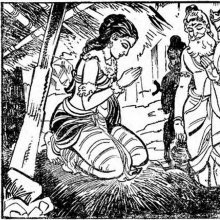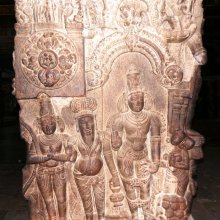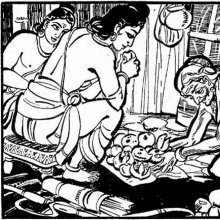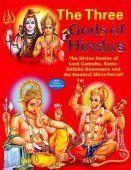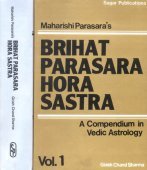Curse, Cursing, Cursed: 3 definitions
Introduction:
Curse means something in Buddhism, Pali, Hinduism, Sanskrit. If you want to know the exact meaning, history, etymology or English translation of this term then check out the descriptions on this page. Add your comment or reference to a book if you want to contribute to this summary article.
Images (photo gallery)
In Hinduism
Yoga (school of philosophy)
Source: ORA: Amanaska (king of all yogas): A Critical Edition and Annotated Translation by Jason BirchCurses (as opposed to Favours) are denoted by the Sanskrit term Śāpa, according to the Amanaska Yoga treatise dealing with meditation, absorption, yogic powers and liberation.—Accordingly, as Īśvara says to Vāmadeva: “[...] [Now], I shall define the nature of that highest, mind-free absorption which arises for those devoted to constant practice. [...] By means of an absorption for nine nights, [the Yogin] who abides in his own undivided self has the Siddhi of speech, which can effect a favour or curse (śāpa). [...]”.

Yoga is originally considered a branch of Hindu philosophy (astika), but both ancient and modern Yoga combine the physical, mental and spiritual. Yoga teaches various physical techniques also known as āsanas (postures), used for various purposes (eg., meditation, contemplation, relaxation).
Natyashastra (theatrics and dramaturgy)
Source: Shodhganga: Literary estimate of mudraraksasaCurses are denoted by the Sanskrit term Abhiśāpa, and should be avoided on a stage (where a dramatic play is performed).—A Nāṭaka should contain pañcasandhis which indicate five successive stages of the drama. This criterion also is present in the Mudrārākṣasa. [...] In the Sāhityadarpaṇa, Viśvanātha gives a list of certain actions which should not be presented on the stage. These are [e.g., Abhiśāpa (curse)] [...].

Natyashastra (नाट्यशास्त्र, nāṭyaśāstra) refers to both the ancient Indian tradition (shastra) of performing arts, (natya—theatrics, drama, dance, music), as well as the name of a Sanskrit work dealing with these subjects. It also teaches the rules for composing Dramatic plays (nataka), construction and performance of Theater, and Poetic works (kavya).
In Buddhism
Tibetan Buddhism (Vajrayana or tantric Buddhism)
Source: ORA: Amanaska (king of all yogas): (Tibetan Buddhism)Curses are denoted by the Sanskrit term Nigraha, according to verse 14.24bd-27 of the Laghuśaṃvara, an ancient Buddhist Yoginī Tantra.—Accordingly: “The Sādhaka [who has] the Siddhi of speech can certainly attract a king or queen by [merely] thinking [it]. He quickly controls gods, demons and men. When angry, he can kill with his speech and drive away his adversary. The practitioner can thus effect a curse (nigraha) with his speech [...]”.

Tibetan Buddhism includes schools such as Nyingma, Kadampa, Kagyu and Gelug. Their primary canon of literature is divided in two broad categories: The Kangyur, which consists of Buddha’s words, and the Tengyur, which includes commentaries from various sources. Esotericism and tantra techniques (vajrayāna) are collected indepently.
See also (Relevant definitions)
Starts with: Curse of india, Cursed buttercup, Cursed crowsfoot, Cursed shade, Cursed thistle.
Ends with: Ellington curse, Gallons curse.
Full-text (+1181): Shapa, Abhisapa, Sapita, Abhishapta, Sapta, Abhisapana, Pratishapa, Galipradana, Sapana, Shapagrasta, Shapamukta, Abhishasti, Parishapa, Sapatha, Shapambu, Abhishap, Akroshana, Shapodaka, Shap, Tarjana.
Relevant text
Search found 222 books and stories containing Curse, Cursing, Cursed; (plurals include: Curses, Cursings, Curseds). You can also click to the full overview containing English textual excerpts. Below are direct links for the most relevant articles:
The Gautami Mahatmya (by G. P. Bhatt)
Chapter 76 - Yāyātatīrtha and other Holy Centres
Chapter 82 - Nandītaṭa and other Holy Centres
Brihad Bhagavatamrita (commentary) (by Śrī Śrīmad Bhaktivedānta Nārāyana Gosvāmī Mahārāja)
Verse 1.4.14 < [Chapter 4 - Bhakta (the devotee)]
Verse 2.2.23 < [Chapter 2 - Jñāna (knowledge)]
Verse 2.1.29 < [Chapter 1 - Vairāgya (renunciation)]
Matangalila and Hastyayurveda (study) (by Chandrima Das)
Curses borne by Elephants < [Chapter 4]
Hybrid and Sea-creatures < [Chapter 4]
Gajendra-Mokṣa (Gajendra’s salvation) < [Chapter 4]
Garga Samhita (English) (by Danavir Goswami)
Verse 2.13.10 < [Chapter 13 - The Story of Śeṣa]
Verse 5.21.18 < [Chapter 21 - The Story of Śrī Nārada]
Verse 6.10.41 < [Chapter 10 - In the Description of the Gomatī River, the Glories of Cakra-tīrtha]
Puranic encyclopaedia (by Vettam Mani)
Related products
(+1 more products available)
